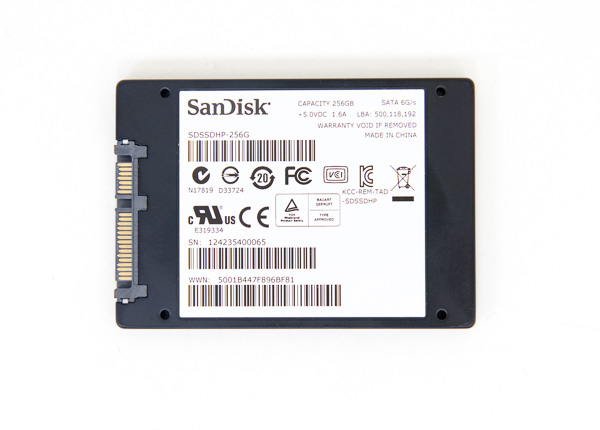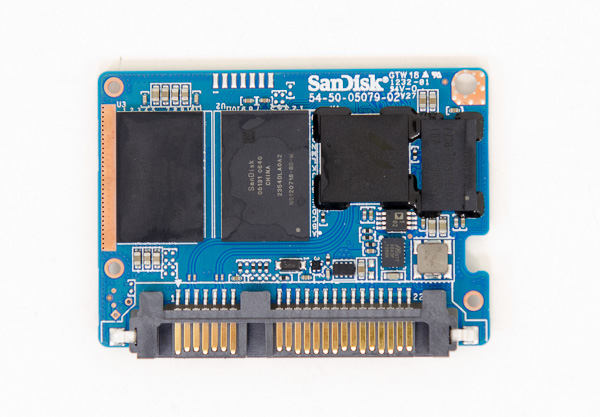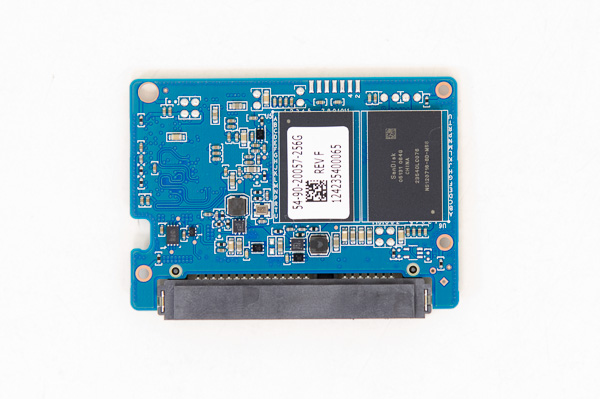SanDisk Ultra Plus SSD Review (256GB)
by Anand Lal Shimpi on January 7, 2013 9:00 AM ESTFinal Words
The Ultra Plus isn't the fastest drive we've ever tested, and most other drives in its price range tend to deliver better performance. Worst case performance consistency isn't great but it's better than Samsung's SSD 840 Pro, so you're going to want to leave at least 25% of the drive free in order to avoid annoying performance variation. The drive's redeeming qualities are basically that it is still a decent performer (way better than a hard drive), and is reasonably low power. The drive PCB itself is very small, potentially paving the way for some interesting, smaller-than-2.5" form factors.
The SanDisk brand likely means something here as well. Any company that has to supply to major OEMs has to have good validation and qualification methods in place, which I'd hope translates into good reliability for the Ultra Plus.
Overall the Ultra Plus is a tough drive to recommend over other similarly priced SSDs simply because it doesn't perform as well as its competitors same price class. If low power is a concern however, the Ultra Plus may fit the bill if you have a niche application. Unlike many SSDs in the past, even though the Ultra Plus isn't the best, it's still better than a hard drive. If you can find one for significantly less than its MSRP and are looking to upgrade a light use system to an SSD, I wouldn't have a problem considering the drive. The trick would be finding an Ultra Plus that's cheaper than the Samsung SSD 840 and the Intel SSD 335, which I'm not sure will happen all that frequently.
Architecturally I'd like to see something more aggressive from SanDisk. Samsung needs another competitor and I believe SanDisk could be that competitor, but it needs to get more aggressive on pursuing performance. SanDisk already has the power side figured out, the question is whether or not it can drive performance up even higher at the same time.
Most of my experiences with SanDisk drives have been in OEM systems, and there I haven't been pleased. OEMs tend to like SanDisk thanks to its very attractive pricing and reliability track record. If the Ultra Plus' controller + firmware combination can make it to SanDisk's OEM client products, I'll be a lot happier.













38 Comments
View All Comments
Flunk - Monday, January 7, 2013 - link
If you want real performance you could make a versio of this that features two of these PCBs along with a RAID chip for enhanced performance. All in a 2.5" form factor would be quite compelling.bmgoodman - Monday, January 7, 2013 - link
Sorry, but after the way SanDisk handled the TRIM issue on their SanDisk Extreme hard drives last year, I will NEVER buy from them again. I understand mistakes are made and things don't go as expected, but for the longest time they simply would not comment at all on the problem. Their response plan to bury their heads in the sand is NOT a strategy for good customer support.Quoth the raven, "nevermore!"
magnetar - Monday, January 7, 2013 - link
IMO, SanDisk handled the SandForce 5.0 firmware TRIM issue as it needed to be dealt with, carefully and professionally.The weak statement about it from a SanDIsk forum moderator that was buried in a thread started by a SanDisk customer was apparently missed by most of those concerned about this issue. That was a mistake. Responding to angry demands for a release date is not professional.
The other SSD manufactures that provided the fixed firmware very quickly were not doing their customers a favor. That indicated to me that those manufactures did very little testing and verification of the new firmware. Considering that all the SSD manufactures that used the 5.0 firmware, and SandForce itself missed finding the problem, a careful approach with the new firmware was warranted.
The firmware update SanDisk provided not only included the fixed firmware, but other fixes as well, including a fix for the incorrect temperature reading some of the Extreme SSDs had. SanDisk chose to provide one update with multiple fixes, rather than multiple firmware updates, which was the better option IMO. The more firmware updates necessary, the less professional the product is.
The R211 firmware update program SanDisk provided was the best one I've ever used. Running in Windows, it worked with the SanDisk Ex connected to the Marvell 9128 SATA chipset! Any other firmware update programs can do that? The lack of complaints about that firmware update program in the SanDisk forum also indicates how good it is.
No blemish on SanDisk IMO, actually exactly the opposite.
Kevin G - Monday, January 7, 2013 - link
Looking at the PCB for this drive makes me feel that this was a precursor to an mSATA version down the road. Hacking off the SATA and power connector for an edge connector looks like it'd be the right size. Kinda makes one wonder why they just didn't using a mSATA to SATA adapter in a 2.5" enclosure and launch both products simultaneously.Kristian Vättö - Monday, January 7, 2013 - link
SanDisk X110 was launched alongside the Ultra Plus, which is essentially an mSATA version of the Ultra Plus.perrydoell - Tuesday, January 8, 2013 - link
How about making the PCB 4x larger... 1GB SSD drive!vanwazltoff - Monday, January 7, 2013 - link
most companies purposely put out a high performing ssd and a low performing ssd, this probably their low end or more likely they are trying to shrink power consumption and size for smaller form factors such as tablets. sandisks extreme ssd went toe to toe with an 830 and proved itself a worthy component with more leveled results than an 830. i am sure they will have answer to the 840 pro soon enoughDeath666Angel - Monday, January 7, 2013 - link
The Extreme was a normal SF-2281 offering with Toggle Mode NAND. Nothing fancy about that imho.iaco - Monday, January 7, 2013 - link
64 GB packages. Verrrry nice.Tells me what we've known all along: Apple has no excuse charging obscene prices for NAND on their iPads, iPhones and Macs. 64 GB probably costs what, $50 at retail? Apple wants $200 to upgrade from 16 to 64 GB.
Maybe they'll finally get around to updating the iPod classic.
Kristian Vättö - Monday, January 7, 2013 - link
8GB 2-bit-per-cell MLC contract price is currently $4.58 ($0.57) on average according to inSpectrum. That would put the cost of 64GB MLC NAND to $36.50. Price depends on quality, though, but smartphones/tablets in general don't use the highest quality NAND (the best dies are usually preserved for SSDs, the second tier NAND is for phones/tablets).